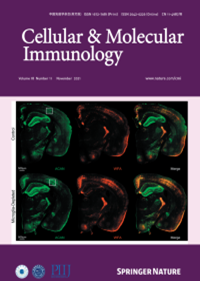MASLD的免疫致病机制和免疫调节治疗。
IF 19.8
1区 医学
Q1 IMMUNOLOGY
引用次数: 0
摘要
代谢功能障碍相关脂肪变性肝病(MASLD),以前称为非酒精性脂肪性肝病(NAFLD),是全球最普遍的慢性肝病,估计全球患病率约为30%;然而,由于其复杂的发病机制和病因,有效的药物治疗仍然有限。因此,迫切需要对疾病的发病机制有更深入的了解。越来越多的研究表明,MASLD及其进行性形式代谢功能障碍相关脂肪性肝炎(MASH)是由慢性营养过剩、多种遗传易感性因素和致病后果(包括肝细胞损伤和肝脏炎症)驱动的。肝脏炎症是促进从单纯脂肪变性到脂肪性肝炎和纤维化转变的关键事件。目前治疗MASH的方法,包括最近批准的甲状腺激素受体激动剂雷司替罗或可用的肠促胰岛素模拟药物,主要针对肝脏的代谢性损伤,而不是直接炎症。在这篇综述中,我们深入讨论了MASLD的免疫学机制的最新数据,并总结了目前和实验治疗对MASLD免疫调节的影响。本文章由计算机程序翻译,如有差异,请以英文原文为准。

Immunopathogenic mechanisms and immunoregulatory therapies in MASLD
Metabolic dysfunction-associated steatotic liver disease (MASLD), previously known as nonalcoholic fatty liver disease (NAFLD), is the most prevalent chronic liver disease worldwide, with an estimated global prevalence of approximately 30%; however, effective pharmacotherapies are still limited due to its complex pathogenesis and etiology. Therefore, a more thorough understanding of disease pathogenesis is urgently needed. An increasing number of studies suggest that MASLD and its progressive form, metabolic dysfunction-associated steatohepatitis (MASH), are driven by chronic overnutrition, multiple genetic susceptibility factors, and pathogenic consequences, including hepatocyte damage and liver inflammation. Hepatic inflammation is the key event fueling the conversion from simple steatosis to steatohepatitis and fibrosis. Current therapies for MASH, including the recently approved thyroid hormone receptor-beta agonist resmetirom or the available incretin mimetics, mainly target metabolic injury to the liver but not inflammation directly. In this review, we provide an in-depth discussion of current data related to the immunological mechanisms of MASLD and summarize the effects of current and experimental therapies on immunoregulation in MASLD.
求助全文
通过发布文献求助,成功后即可免费获取论文全文。
去求助
来源期刊
CiteScore
31.20
自引率
1.20%
发文量
903
审稿时长
1 months
期刊介绍:
Cellular & Molecular Immunology, a monthly journal from the Chinese Society of Immunology and the University of Science and Technology of China, serves as a comprehensive platform covering both basic immunology research and clinical applications. The journal publishes a variety of article types, including Articles, Review Articles, Mini Reviews, and Short Communications, focusing on diverse aspects of cellular and molecular immunology.

 求助内容:
求助内容: 应助结果提醒方式:
应助结果提醒方式:


